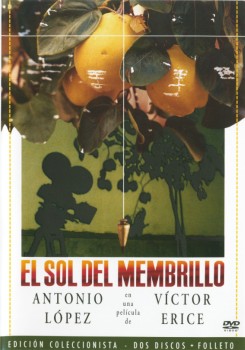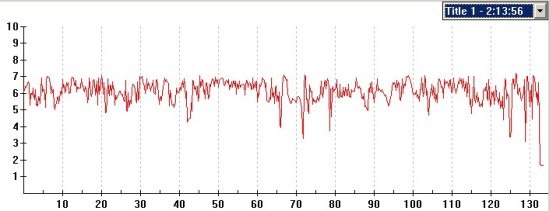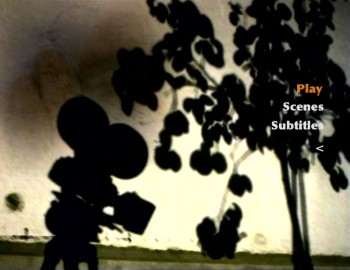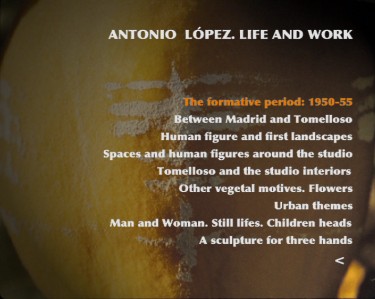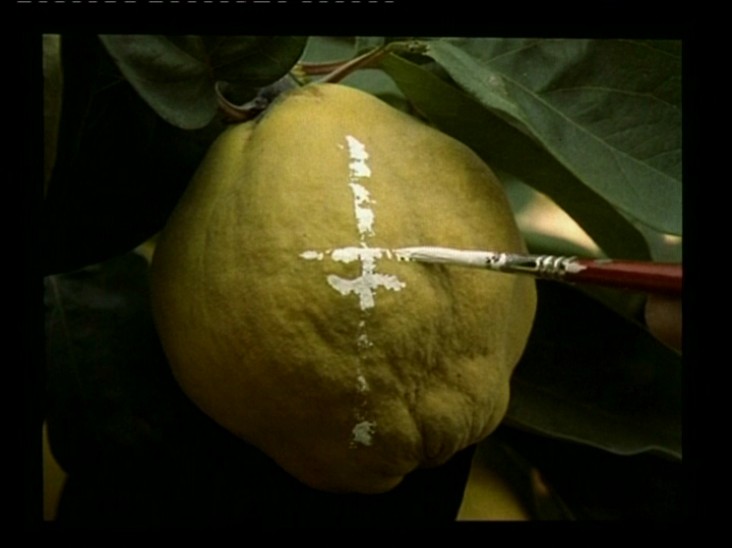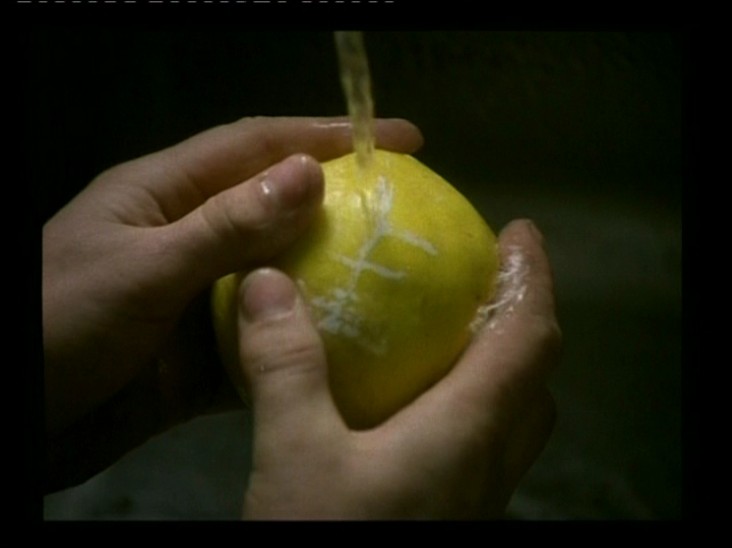![]()
![]()

![]()
![]()
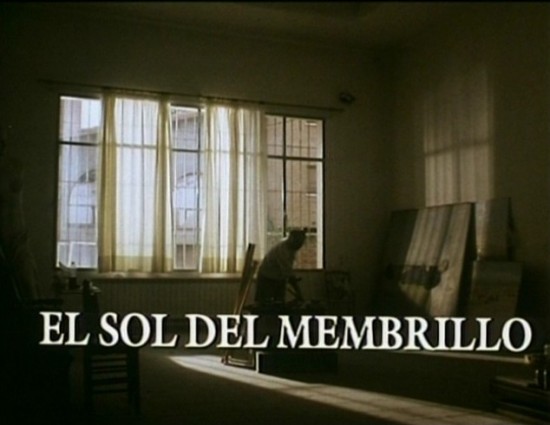
(aka "The sun of the Quince" or "Quince Tree of the Sun" or "Dream of Light")
directed
by Victor Erice
Spain 1992
We are in front of a not conventional movie. In fact, we can
ask ourselves if this is a "movie" indeed, perhaps is better call it as a
"film". By the way, we are in front of an art work.... better.... an art
film.... and even better a art film about art creation.
The film of Erice is a very risky bet. The film was started without a script,
and close to an experiment. I can assure that, although there are not abstract
forms, strident music and a chaotic plot, THIS is an experimental film.... In
the other side, I ask myself... Is this a documentary film?. I can not assure
that, but is close to. This is a film, perfect for a video-forum about "What
is a doc?".
In "El Sol del membrillo" we find that the people who appear are
their selves,
and act, but they act in their everyday life with some hints made by the
director of the film. There are no a written line of script, and this can be
easily seen, because they are many times tense about the presence of the
camera, and their behavior are unnatural but is not fiction. The dialogues
are plenty true, but they flow scared because the presence of the filming
unit.
We are in front of a film where is no any dialogue in the first 20minutes,
more than a "Hello, How are you?". This occurs also because there is no ANY
voice in off, in difference with TV documentaries. In this aspect, we can say
that Erice tries to be an objective viewer. We can watch. And we can listen...
We should discover the film, the film is not explained himself, it should be
discovered actively by the viewer.
The film plot is simple and also minimalist, Antonio López (famous Spanish
painter) begins to paint a Quince Tree trying to capture the light of the
early Autumn in it... the rest of the plot is reality. Adventures in the
courtyard of a suburb of Madrid, while it rains, and conversations with
friends or visitors.
Why to made this film? Erice wants to be a witness through the cinema, of an
artistic creation. This film is a reflection about art itself, about picture
art, about cinema art and about life itself. This is a work about the
necessity
of artistic expression. A need to search of something that appears inside the
heart.
Erice approaches to Antonio López in a search. Erice said recently "I think I
made the film trying to understand what was behind. I had to make the film to
sense something, to achieve certain kind of truth". Erice think that he was
not innovating, in fact it was more a return to the origins of film making. A
return to Lumiere. We are talking about the Language of cinema itself, the
cinema have the possibility of capture the appearance of the things.
In this film, we can also perceive a "life style". The living style of an
mature artist. This brings up a reflection about the creation of art. The art
work doesn't develops to reach the completeness, it doesn't bother if you
reach to complete it or not. The main thing is develop it, and the
relationship between the artist and his growing art work. It is a concept of
absolute independence of creation, when the artist is not forced to finish the
work in a time. This way of working is only possible when there is a way of
living and certain philosophy of life. A philosophy away from hysteria stress
and fast food, and closer to Zen and spirituality. A discovery of the
happiness through a life based on the developing of a artistic process.
Antonio Lopez says about this: "It's been a long time since I've talked of
'finishing a painting', A painting never ends. It's always open. If you have
already put enough into it, not everything, but enough, you could go on but
then come the difficulties, fatigue, commitments and the desire of starting a
new work. The painting is then suspended but never finished."
The film also talks about the modern world, and the style of living. About TV
phenomenon, and about modern society. A snapshot of the Metropoli of Madrid,
that I feel realistic.
This is a film for meditation, for think in art and life. And for watching
many times. Erice gives you time to think, and to relax. Take time, breathe
deep, and let's watch this unique film.
Posters
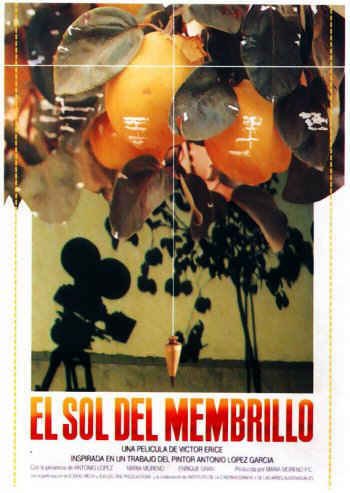 |
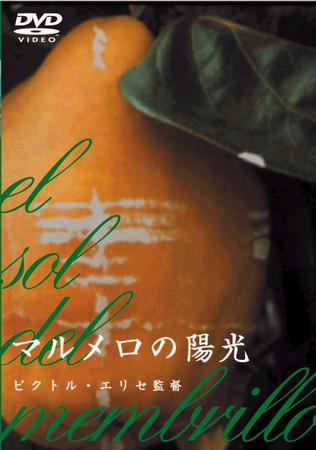 |
Theatrical Release: Spain 20 January 1993
Reviews More Reviews DVD Reviews
DVD Review: Rosebud - Region 2 - PAL
| DVD Box Cover |
|
CLICK to order from:
|
| Distribution |
Rosebud Region 2 - PAL |
|
| Runtime | 2:14:03 (4% PAL speedup) | |
| Video |
4:3
Original Aspect Ratio |
|
|
NOTE: The Vertical axis represents the bits transferred per second. The Horizontal is the time in minutes. |
||
| Bitrate |
|
|
| Audio | Dolby Digital 2.0 Stereo | |
| Subtitles | English, French, Italian, German, Portuguese and Spanish | |
| Features |
Release Information: Studio: Rosebud Aspect Ratio: Edition Details:
DVD
Release Date: 07-Oct-2004 Chapters 30 |
|
| Comments |
This edition has been a
release of a very small independent company (Rosebud Films), with direct
participation of the original producers and participants of the film:
Victor Erice, Jos Oliver, Antonio López(the painter) and María Moreno
(wife of the painter) Rosebud films is the same company who released the VHS in the Spanish market some years ago (VHS). There were very few copies of the VHS, and soon was impossible to find out. If we examine the VHS we notice that is mainly the same master, it is exactly the same time long, and the transfer is not straight, in both sources. The image respect the horizontal is in an angle of 3degrees, we can notice in the credits (see here and here) Other differences with the VHS are that there are ingrained Spanish subs in the VHS when the Polish workers talk. In the DVD we have removable subtitles, even in Spanish. The third difference is in the parts of the film which were shot in Betacam-SP. This film, is made in two formats 35mm+BetacamSP. In VHS the parts in Betacam are difficult noticeable, they seem similar to 35mm parts, but in the DVD there are clear jumps in the movie when you pass to a Betacam part (see capture 4). The color curve is very different, and the granularity of the film change drastically. It seems, that the master of the DVD was made copying the master Betacam sources again PAL to PAL in the Betacam parts, while in the VHS the whole film comes from a transfer of a 35mm copy with the Betacam transferred in 35mm before. In the booklet there is a nice statistics about the parts shot in Betacam and 35mm. It says: Length: 3793m , 2h18m56s Photography by:
Also there are some weird effects typical of interlaced video, in the scene of the ruler ( and in other parts of the film, but they are original from the telecine, because they are also in the VHS, but they are more noticeable in the DVD. The image has some scratches and dust, but they don't disturb the viewing experience. There are more small problems, like an BUG in the MPEG2 stream in the beginning of chapter 18. My DVD player, and some more (of friends) freeze when reaching this point. Although is not a serious failure (you can fix, giving a little to forward button to pass to the next second), is clearly an authoring fail. In the captures we can see also a special code in the first line of the image. This is typical of recording in DV cameras through analog input. I am not sure what type of code is, but it appears in most videos of the DVD, including the DVD animation menus, and the photo slideshows. It seems like all the videos were copied through an analogical interface to a DV tape for the Authoring lab. Only two sources have not this code. The clips of the films of Erice, and the TVE interview. About the sound, I can say that is really good. I love the sound in this film, is clear and full of details, it sounds quite natural, and is real recorded sound, not like in other movies. The quality is so high that in some scenes you can hear the noise of the camera very faint in the background. About the subtitles, I have reviewed the English ones, and I think they are close to perfect, in the translation. They are very complete. Perhaps too complete, because in some dialogues they run very fast, and perhaps are difficult to follow, but they are really good in meaning. This is a very special edition, in the Spanish market is very rare see an independent company releasing DVDs, and this is the reason because they have made an exclusive with FNAC stores, who have given them advertising and a nice distribution in all big towns of Spain. The participants in the production of the DVD are the same who made the film, so there is a lot of love, and care in the production, and you can feel it. The menus are authored with love, and the subtitles in English are terribly PERFECT and very complete. The menus are in the 6 languages of the subtitles, and are very good. The authoring is complex and easy to follow, specially in the second DVD with the extras. In this extras DVD we can find a lot of work and love in the making of this edition. The extras mainly consists of medium quality videos some of them seem in hi quality home-video (Im sure that they are Hi8), two eliminated scenes and a interview taken from a popular TV program about Spanish cinema(Versión Española web here: Main page of the program and Page about El sol del Membrillo). Apuntes (1990-2003) (29m10s) were completed in January 2003, with images shot by Erice in the Summer of 1990, when he was preparing the movie, and observing how worked the painter. This images has been edited for this DVD in 2003, and Victor Erice has written and selected the texts who illustrate them. In each of the 6 parts of Apuntes we can observe how works Antonio in 6 different projects, there are very few comments, and most of the sound are ambient, like in home-movies. All this are really documentary. This documentary was copied through a composite cable in some part of the process, and the colors suffer from typical effects of interference. Conversacion with Victor Erice and Antonio López (38m19s) Is an exclusive interview in program Version Española with Cayetana Guillen Cuervo. The images has a strange lo quality and suffer from big-pixel effects (see capture). It seems a very bad transfer. The image also vibrates like having a problem in the interlacing. It looks well on TVs, bad on computer. The interview is translated VERY well, and the contents are quite interesting. Erice makes the discourse very precise and builds all his ideas with great exactitude, while we can notice that Antonio is a very nice person, with very clear ideas about life and art. Eliminated scenes(18m) We see the complete scene of the visit of the friends (chapter 20), that is reduced from 9minutes to 3m18s in the movie. Also appears a completely deleted scene where Enrique Gran and Antonio López talk about the famous painting of Velázquez: "Las Meninas" In the book There is a very complete relationship of the visual contents of the DVDs. Also there is basic film information, the famous list of the Cinematheque of Ontario, where it appeared as "The best film of the 90s", (nice to see Tarr's Kaurismaki and Kiarostami in the first 15 positions). Also there are the complete list of the 240 images of the portfolio and several articles, one about the Movie, one of the history of the film, an Interview to Erice, and complete Biographies (through many pages) that explain the life and work of the artists that MADE the film, like Aguirresarobe (photo) or Gaigne(composer of the score), and the artists that APPEAR in the film, Maria Moreno , Enrique Gran, José Carretero, Amalia Avia, Lucio Muñoz, Julio López and Esperanza Parada. Finally the book closes with a complete biography. Also we can enjoy in the DVD a lot of quality photos and images (240) of the paintings and of the painters. You can enjoy them in carefully edited video slideshows (with an intro), or in hi-quality still images, that are really good in quality. The labels of the photos and paintings are translated to the 3 main languages (English, French and Spanish). We can notice a really huge work of investigation to find all the images, that most came from personal archives and digitizing all of them. Then, the work of authoring of the DVD with all the images carefully classified are really good. The menus and subtitles on the EXTRAS DVD are only in English, French and Spanish. |
DVD Menus
|
|
|
|
|
|
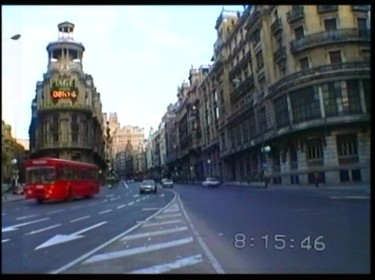 |
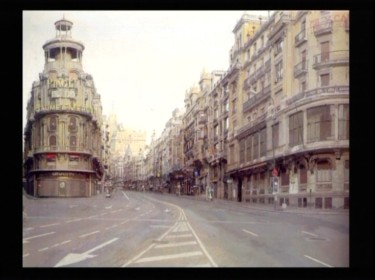 |
Screen Captures
|
|
|
|
|
|
|
|
|
|
|
|
|
|
|
|
|
|
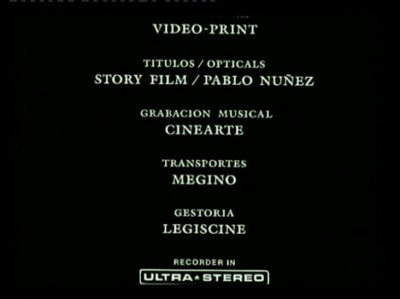 |
|
